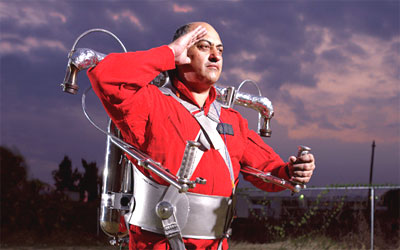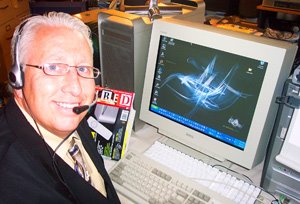Backyard Buck Rogers!
++ Juan Lazano / Backyard Rocketeer
Personal Tech :: From Buck Rogers to 007, the rocket pack has fueled our greatest personal-technology fantasies.
For Juan Lozano, it has inspired a lifelong obsession! The road to a rocket-belt flight is long. Today Lozano, 51, will attempt his 12th tethered flight since he first deemed his rocket belt ready for liftoff. Eight years and more than half a million dollars after he began building his device.
 Lozano’s dream began when he was seven years old. It was February 1963, and NASA had brought its American space expo to the Campo Marte polo grounds in Mexico City. The expo’s star feature was the Bell Rocket Belt! Few, if any, of the 620,000 observers at the NASA expo would ever again see the likes of what they saw that February. Despite the great optimism of the early ’60s, in the rocket belt’s brief history, only 12 souls have flown one. More people have walked on the moon. But Juan Manuel Lozano didn’t want to go to the moon. It is the dream of flying that has him hooked!
Lozano’s dream began when he was seven years old. It was February 1963, and NASA had brought its American space expo to the Campo Marte polo grounds in Mexico City. The expo’s star feature was the Bell Rocket Belt! Few, if any, of the 620,000 observers at the NASA expo would ever again see the likes of what they saw that February. Despite the great optimism of the early ’60s, in the rocket belt’s brief history, only 12 souls have flown one. More people have walked on the moon. But Juan Manuel Lozano didn’t want to go to the moon. It is the dream of flying that has him hooked!“I have flown everything—gyrocopters, helicopters and aerobatic planes,” Lozano says. “The rocket belt is the hardest. If you can learn to fly a rocket belt, you can learn to fly anything!”Lozano’s strategy is simple: Do it yourself, study the results, then do it again. To build his rocket belt, he has turned himself into a one-man team—researcher, designer, test pilot. The hope is that everything he has learned will lead to an untethered flight on a rocket belt of his own design and construction. If all goes as planned, he’ll then be able to sell a complete turnkey package of fuel machine, custom-fit rocket belt, flying instruction and tech support for $350,000. Two sales, and he will have made back his personal investment, with a little spare change for his next project.
The first thing he had to do was learn how to make his own fuel. Hydrogen Peroxide was his ticket to paradise. It was costly, for one thing, so unless he made it himself, training would be prohibitively expensive. Engineers and chemists alike told him that a person couldn’t make his own rocket fuel. And for good reason: Hydrogen peroxide is no joke. The stuff in your medicine cabinet that you use to clean a cut is about 3 percent hydrogen peroxide. The stuff that bleaches your hair is 6 percent. The stuff in a rocket-belt tank is 90 percent.
However, after eight versions of his Hydrogen Peroxide machine and, yes, 19 years later, Lozano was satisfied. It took that long to perfect the distillation, a process of delicately separating water from the peroxide.
 Next, it was time to turn his attention to the catalyst pack, one that could react as powerfully as possible with his Hydrogen Peroxide. He found inspiration at his day job. In the back of the jewelry shop, Lozano mixed metals in small glass containers and noticed how different alloys and proportions caused slight changes in reactions and temperature. After two years of testing, he created what he calls the “penta-metallic catalyst pack,” composed of silver, gold, platinum, palladium and rhodium. Certain that he had derived the most reactive catalyst ever tested with Hydrogen Peroxide, he went about building not one or two but three working rocket belts.
Next, it was time to turn his attention to the catalyst pack, one that could react as powerfully as possible with his Hydrogen Peroxide. He found inspiration at his day job. In the back of the jewelry shop, Lozano mixed metals in small glass containers and noticed how different alloys and proportions caused slight changes in reactions and temperature. After two years of testing, he created what he calls the “penta-metallic catalyst pack,” composed of silver, gold, platinum, palladium and rhodium. Certain that he had derived the most reactive catalyst ever tested with Hydrogen Peroxide, he went about building not one or two but three working rocket belts.Note from Technophile: When Wendell Moore created the first rocket belt, he had a lot of help. His team included advisers from the U.S. space program, as well as physicians, ergonomics experts, exotic-metal welders, machinists, draftsmen and materials-testing technicians. Lozano’s team is considerably leaner. With every test flight, Lozano learns more about his rocket belt and how to control it. When you’re flying a machine with multiple points of control and 800 horsepower coming off your back, any tiny adjustment can make a huge difference in your trip! Each time Lozano flies, he gets a little closer to removing the tether and flying free. If he flies free, he can sell at least one of his belts so he can continue to fund his work. If he flies free, he can line up endorsement deals and get handsomely paid to propel himself or an apprentice over a soccer game. If he flies free, he becomes a member of one of the most exclusive clubs in history!:: Source: [Popular Science]
:: Innovation: Using a rocket pack to fly free!
:: Available: Soon.
:: Cost: $350,000 USD
:: Image Credits: John B. Carnett




















0 Comments:
Post a Comment
<< Home